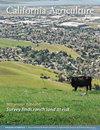Microbiome interactions and their ecological implications at the Salton Sea
IF 1.1
4区 农林科学
Q2 AGRICULTURE, MULTIDISCIPLINARY
引用次数: 4
Abstract
Although the Salton Sea was once a thriving destination for humans and wildlife, it has now degraded to the point of ecosystem collapse. Increases in local dust emissions have introduced aeolian (wind-blown) microorganisms that travel, along with contaminants and minerals, into the atmosphere, detrimentally impacting inhabitants of the region. Proliferation of certain microbial groups in regions of the Sea may have a disproportionate impact on local ecological systems. Yet, little is known about how the biogeochemical processes of this drying lakebed influence microbial community composition and dispersal. To elucidate how these microorganisms contribute, and adapt, to the Sea's volatile conditions, we synthesize research on three niche-specific microbiomes — exposed lakebed (playa), the Sea, and aeolian — and highlight modern molecular techniques, such as metagenomics, coupled with physical science methodologies, including transport modeling, to predict how the drying lakebed will affect microbial processes. We argue that an explicit consideration of microbial groups within this system is needed to provide vital information about the distribution and functional roles of ecologically pertinent microbial groups. Such knowledge could help inform regulatory measures aimed at restoring the health of the Sea's human and ecological systems.索尔顿海微生物组相互作用及其生态意义
尽管索尔顿海曾经是人类和野生动物的繁荣目的地,但现在它已经退化到生态系统崩溃的地步。当地灰尘排放量的增加将风(风吹)微生物与污染物和矿物一起传播到大气中,对该地区的居民产生了不利影响。某些微生物群在海洋地区的扩散可能对当地生态系统产生不成比例的影响。然而,人们对这种干燥湖床的生物地球化学过程如何影响微生物群落组成和扩散知之甚少。为了阐明这些微生物是如何对海洋的挥发性条件做出贡献和适应的,我们综合了对三种特定生态位微生物群的研究——暴露的湖床(playa)、海洋和风成微生物群——并强调了现代分子技术,如宏基因组学,再加上物理科学方法,包括运输建模,以预测干燥湖床将如何影响微生物过程。我们认为,需要明确考虑该系统中的微生物群,以提供有关生态相关微生物群的分布和功能作用的重要信息。这些知识有助于为旨在恢复海洋人类和生态系统健康的监管措施提供信息。
本文章由计算机程序翻译,如有差异,请以英文原文为准。
求助全文
约1分钟内获得全文
求助全文
来源期刊

California Agriculture
农林科学-农业综合
CiteScore
2.40
自引率
7.70%
发文量
17
审稿时长
>12 weeks
期刊介绍:
Information not localized
 求助内容:
求助内容: 应助结果提醒方式:
应助结果提醒方式:


